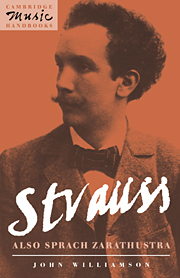Summary
Strauss and the leitmotif
Broadly speaking, three views of structure in Also sprach Zarathustra have been put forward with varying degrees of rigour and subtlety, founded respectively on motivic-thematic factors independent of exact formal structures, on themes in a variation context, and on the idea of the symphony. What may be slightly surprising is the degree to which tonality has been taken as the ally not of the symphonic view, but of those who have argued for some kind of dramatic form with leitmotifs. That the whole work pivots round the antithesis of C and B is beyond dispute, having a firm grounding in Strauss's own comments. Problems immediately occur when the question of the ascendancy of one or the other arises, however, since Strauss never quite settles on either as the tonic, keeping both fairly constantly in play. Thus both keys are heard in the first thirty-four bars, with C rather the stronger. As if in compensation, the closing pages again feature both keys, with B now clearly stronger. If this famous ending is looked at with any degree of analytical rigour, it must be doubted whether C is present as a key in any meaningful sense. The chord, C–E–F#, which Strauss places over the theme of the World Riddle or universe (bars 980–2), resolves with little effort into B major (Ex. 7a).
To describe this ending as bitonal is rather like saying that the ending of Liszt's B minor Sonata is potentially bitonal.
- Type
- Chapter
- Information
- Strauss: Also sprach Zarathustra , pp. 70 - 87Publisher: Cambridge University PressPrint publication year: 1993



